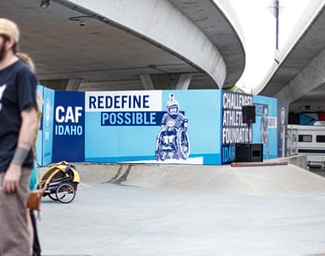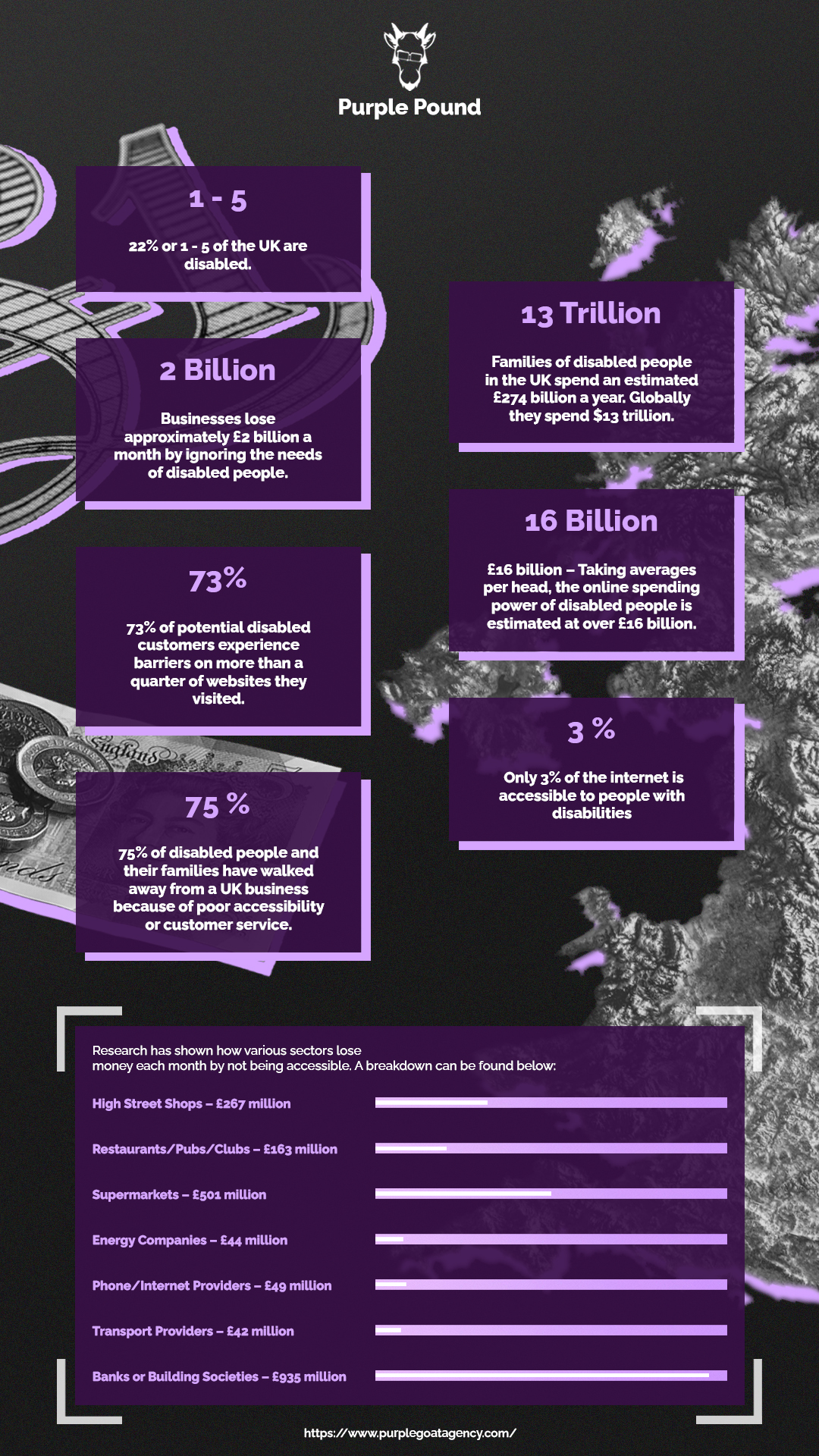Businesses are missing out on the purple pound, says Scope
Sarah Botterill | 26 Nov 2019
This article is informed by Scope's session at TechShare Pro 2019 where it unveiled its Big Hack project to understand the role of Inclusive Design to meet the needs of disabled people.
Seventy-five per cent of disabled people think businesses are losing out due to poor inclusive design, according to research by Scope unveiled at TechShare Pro 2019. With 11 million of the 27 million households in the UK, or 40% of them, including at least one disabled member business is missing out on a potential £2.74bn.
 “Disabled people in the UK, particularly those with mild to moderate disabilities, comprise a greater proportion of the population than ever before,” says Scope.
“Disabled people in the UK, particularly those with mild to moderate disabilities, comprise a greater proportion of the population than ever before,” says Scope.
Under the umbrella of The Big Hack Scope’s research is part of a campaign to engage the tech community, and to bust through the barriers disabled people face.
Researchers surveyed almost 300 disabled people to find out how they spend their cash; and where they’re unable to spend it, why, and to establish the role of Inclusive Design.
- 1 in 5 people in the UK are disabled
- 13.3 million disabled people in the UK
- 40% of households have at least one disabled person
- 11 million households
- £274bn, the value of the ‘purple pound’
“This is a big moment, and businesses are asking themselves the questions why, when and how do we tackle this promising market,” said Craig Moss, Research Manager for Scope. “Business leaders and designers increasingly recognize that their customers occupy a common spectrum of abilities and aptitudes across various areas rather than existing in two separate camps.”
How do disabled people spend their purple pound?
 The research shows that, on average, disabled households are overspending (as a proportion of income) on personal transport (+33%), and personal care products and services (+23%).
The research shows that, on average, disabled households are overspending (as a proportion of income) on personal transport (+33%), and personal care products and services (+23%).
An overspend on personal transport is matched by an underspend on public transport. The Big Hack research found that on average disabled people spend 31% less on public transports, and experience significant problems when travelling.
One respondent commented “my worst experiences with accessibility have been with public transport, which is the most important thing to someone with a disability. I would be happiest to spend more money on it if it were more accessible.”
Scope found on average 22% of disabled people wanted to spend more on public transport but were unable to do so because of accessibility issues.
Bad design is bad for business
A key focus of the Big Hack is to “understand Inclusive Design’s role,” in enabling or stopping, disabled people from spending their money.
Scope found that 75% of survey respondents felt business was losing out due to poor inclusive design.
What’s more, when faced with problems using a website or app, or an in-store device such as a self-checkout machine 50% of respondents didn’t complete the purchase; while 48% found an alternative place to buy – taking their business elsewhere.
“Inclusive design should be a priority for businesses of all sizes,” said Moss. “In a society where our differences are increasingly recognised and celebrated - and not to mention a society that is getting older - it is vital from both an economic and an ethical perspective that marketers respond to the changing design priorities that come with this."
The onus is on designers of products and customer journeys to include disabled people in their business strategies, and that doing so will create a better product for everyone.
“This shift in emphasis has put onus on designers of products [to include] disabled people in their business strategies at the earliest possible point in the design process. It has also led to a greater sense of identification for disabled people, and a breakdown in boundaries between disabled and non-disabled consumers,” said Moss.
“Business leaders and designers increasingly recognize that their customers occupy a common spectrum of abilities and aptitudes across various areas rather than existing in two separate camps,” he added.
Put simply, Inclusive Design is good for business. “The business case is rooted in both economics, and in ethics. Users with a range of impairments will constitute a greater proportion of the market and various products and services,” said Moss.
Moss added: “Companies have a duty to respond to a changing world. They must prevent their customers from facing indirect discrimination through markets that isolate and exclude them. In fact, markets can play a significant role in the cost of living to a disabled person and that household, creating unnecessary extra costs and limitation on spending.”
Underspends among disabled people
Poor design means disabled people are underspending in key areas including education, and recreation. The survey found that households with disabled people spend, on average, 65% less on education and as a proportion of income. However, 33% said they’d like to spend more on education but are prevented from doing so because of accessibility issues.
Disabled people are also spending less (-25%) on entertainment and again would like to spend more.
How can Business embrace Inclusive Design?
Scope’s Big Hack resources offer guidance for business including 7 principles for inclusive design.
AbilityNet Accessibility services: AbilityNet offers a range of accessibility services, for support speak to our experts.
Top spending categories for disabled households
1. Food and drink
2. Personal transport
3. Recreation and culture
4. Finance and insurance
5. Clothing and Footwear
6. Entertainment
7. Personal care products/services
8. Public transport and taxis
9. Home and garden
10. Energy
Update 2023: Data about The Purple Pound
The Purple Goat specialist disability marketing agency has created a useful infographic to outline the latest data (2023) about disabled people and business interactions.

The infographic shows the following statistics:
- 1-5: 22% or 1-5 of the UK are disabled
- 2 Billion: Businesses lose approximately £2 billion a month by ignoring the needs of disabled people.
- 13 trillion: Families of disabled people in the UK spend an estimated £274 billion a year. Globally they spend $13 trillion.
- 16 billion: taking average per head, the online spending power of disabled people is estimated at over £16 billion.
- 73% - 73% of potential disabled customers experience barriers on more than a quarter of the websites they visited.
- 75% - 75% of disabled people and their families have walked away from a UK business because of poor accessibility or customer service.
- 3% - Only 3% of the internet is accessible to people with disabilities.
Research has shown that various sectors lose money each month by not being accessible:
- High street shops - £267 million
- Restaurants/Pubs/Clubs - £163 million
- Supermarkets - £501 million
- Energy companies - £44 million
- Phone/Internet providers - £49 million
- Transport providers - £42 million
- Banks or building societies - £935 million
About TechShare Pro
Now in its third year, TechShare Pro 2019 is hosted by Google and supported by some of the biggest technology names on the planet. The conference offers two days to connect, learn and share with people from all over the world who are building a more accessible and inclusive digital world.
Panelists and workshop hosts include Apple, Google, the International Association of Accessibility Professionals, Barclays, RNIB, Uber, Disability Rights Advocate (USA), Disability Rights UK, European Disability Forum, Aira, BBC, Sony, Scope, Fraunhofer, Verizon Media, Amazon, Netflix and Channel 4.
Subscribe to The TechShare Procast - your audio guide to the conference, including highlights and interviews with some of the speakers at the event.
Request the livestream from TechShare Pro 2019 to watch the main conference sessions online.
Join our mailing list to be kept up-to-date with the latest disability and technology news, plus more from TechShare Pro 2019 post-event.



